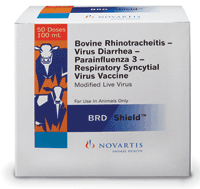- Broad-spectrum protection against viral diseases that contribute to BRD complex
- First and only modified-live vaccine to offer protection against the noncytopathic strain of BVD Type 1 and BVD Type 2
- Developed for use in nonpregnant beef and dairy cattle
- First and only modified-live vaccine to offer protection against the noncytopathic strain of BVD Type 1 and BVD Type 2
 Novartis Animal Health announces the introduction of BRD Shield, a new modified-live vaccine (MLV) developed to protect nonpregnant beef and dairy cattle against bovine respiratory disease (BRD) complex.
Novartis Animal Health announces the introduction of BRD Shield, a new modified-live vaccine (MLV) developed to protect nonpregnant beef and dairy cattle against bovine respiratory disease (BRD) complex.  BRD Shield provides broad-spectrum protection against leading viral diseases that contribute to BRD, including bovine virus diarrhea (BVD) Type 1 and Type 2, infectious bovine rhinotracheitis (IBR), parainfluenza 3 (PI3) and bovine respiratory syncytial virus (BRSV).
BRD Shield provides broad-spectrum protection against leading viral diseases that contribute to BRD, including bovine virus diarrhea (BVD) Type 1 and Type 2, infectious bovine rhinotracheitis (IBR), parainfluenza 3 (PI3) and bovine respiratory syncytial virus (BRSV). "BRD continues to be one of the most costly diseases in the cattle industry and is a major cause of pneumonia and death loss," said Doug Scholz, DVM, director of veterinary services, Novartis Animal Health.1 "Even a mild infection with one of these common viral diseases can weaken the animal's immune system and increase its susceptibility to serious respiratory infection."
BRD Shield represents a significant advance in BVD protection, offering more complete coverage than other MLVs. It is the first and only MLV that includes antigens for protection against the noncytopathic (NCP) biotype of BVD Type 1 and BVD Type 2.
The NCP BVD biotype accounts for 90 95 percent of clinical disease outbreaks and is responsible for 100 percent of persistently infected calves.2
"BRD Shield offers premier protection against the strain of BVD responsible for the most severe and widespread outbreaks," Scholz said. "In a BVD challenge trial performed prior to USDA registration, mortality among a control group of nonvaccinated calves was 83 percent postchallenge, compared to only 5 percent of calves vaccinated with BRD Shield."3
In efficacy trials for IBR, an acute contagious viral disease often implicated as the initiator of BRD, cattle vaccinated with BRD Shield demonstrated significant differences in temperature, respiratory signs and nasal discharge compared to nonvaccinated calves.4
Extensive field testing showed that BRD Shield was proven safe for calves as young as four weeks of age, with no adverse impact on meat or carcass quality when used as directed.
The label indicates beef cattle should receive their initial dose of BRD Shield at weaning, followed by a booster four weeks later. Vaccination of dairy cattle is recommended between two and six weeks of age, followed by a booster at six to 10 weeks of age. In herds at risk of BRSV, animals should be revaccinated three to four weeks after the first dose. Calves vaccinated prior to six months of age should be revaccinated after six months of age.
BRD Shield is labeled for use in healthy nonpregnant cattle. Since MLV vaccines were approved for use in pregnant cows and calves nursing pregnant cows in 2004, diagnostic labs have noted an increase in IBR abortions that may be related to the improper use of MLVs.5
"As an MLV, BRD Shield is best suited for use in calves in vaccination protocols that call for an initial MLV vaccination," Scholz said. "Using an inactivated viral vaccine like Vira Shield® in reproductive females has distinct safety advantages since there is no risk of MLV-induced abortion."
According to the USDA, 29 percent of all U.S. cattle deaths are attributed to BRD with estimated annual losses approaching $3 billion.6 Reduced weight gain and performance is a common and costly effect of BRD in stocker and feeder operations.
For more information about BRD Shield, contact your Novartis Animal Health representative or visit www.livestock.novartis.com.
2.09.2012